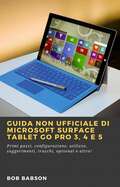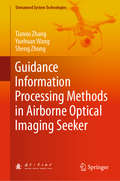- Table View
- List View
Guia Pokémon GO + 20 dicas e truques que você deve ler
by Fernanda Ranieri Silva Game GuidezSeja o melhor treinador Pokémon você pode ser! Em nosso guia, mergulhamos diretamente nas dicas e truques que o ajudarão a se tornar um mestre no menor tempo possível. Nós o guiamos de mãos dadas com algumas das dicas mais cobiçadas e truques descobertos no jogo até agora. Se você quiser acelerar a sua diversão, este é o livro para ir para você! Alguns dos tópicos que abordamos: Começando Encontrando mais pokémons Nivelamento mais rápido e mais eficiente Como encontrar Pokémon em uma equipe Como economizar bateria com estratégias avançadas Itens Dicas e truques de Realidade Aumentada Dicas especiais do Pokéstop Segredos e sugestões Também estão incluídos muito mais dicas, truques e segredos. Se você quiser ler nenhuma enrolação e apenas chegar direto ao ponto, este é o livro para você! Leia a sua cópia hoje e torne-se o mestre que você é!
Guia Prático das Câmeras GoPro Hero e Fusion: Como usar a sua GoPro Fusion e Hero 4/5/6/7 disponíveis em Black e White
by Brad JohnsonAprenda a usar a sua câmera GoPro como um profissional! Este guia é para quem procura capturar vídeos incríveis em seu dispositivo GoPro. Compatível com GoPro Fushion, Hero 4,5,6 e 7. Este livro aborda tudo o que você precisa saber: - Tirar fotos e vídeos incríveis - Fotos de lapso de tempo - Fotografia em movimento - Compartilhando seus vídeos e fotos - Fotografia subaquática - Composição das filmagens - Uso da bateria - Resolução e campo de visão - Uso do estabilizador Gimbal - Técnicas de edição de vídeo - E MAIS!
Guia de Jogo Agar.io
by Hiddenstuff Entertainment Rafael da Silva RamaGuia Não-Oficial do Agar.io por HiddenStuff Entertainment Passa Níveis & Ganha Poderes! *GUIA NÃO-OFICIAL* Para além de comprares este eBook, inscreve-te também no nosso programa suplemento de guia grátis. Ao copiares o link que se encontra em baixo, terás acesso às novidades mais recentes relativas às aplicações e aos videojogos. Inscreve-te gratuitamente em baixo: http://emailsignupform.subscribemenow.com/ Dicas Avançadas & Guia Estratégico. Este é o único guia abrangente e detalhado que encontrarás online. Disponível para download instantâneo no dispositivo eBook do teu telemóvel ou em formato brochura. Com o sucesso das minhas centenas de outros guias e estratégias escritos, escrevi outro guia profissional avançado para jogadores novos e veteranos. Este oferece estratégias e dicas específicas para avançares no jogo, derrotares os teus adversários, adquirires mais moedas e dinheiro, e muito mais! Aqui está o que obterás quando comprares este guia profissional e detalhado - Dicas e Estratégias Profissionais. - Cheats e Hacks. - Segredos, Dicas, Desbloqueadores e Truques Usados Por Jogadores Profissionais! - Como Ganhar Muito Dinheiro/Moedas. - E MUITO MAIS! Todas as versões deste guia têm imagens para te ajudar a entenderes melhor o jogo. Não existe nenhum guia que seja tão abrangente ou avançado como este. Ficarás satisfeito ao comprares este guia e ganharás muito mais com ele do que com outros guias muito menos eficazes. Compra agora e esmaga os teus adversários! Torna-te um Jogador Profissional ainda HOJE! Se precisares de ajuda ou mais informações relativamente aos nossos produtos, visita: http://www.hiddenstuffentertainment.com/ Aviso: Este produto não está associado, afiliado, aprovado, certificado ou financiado pelo Dono Original dos Direitos de Autor. Todas
Guia de Segurança & Backup para PCs: Como Proteger e Fazer Backup do Seu PC com Software Antivírus e Malware
by Jon AlbertUm guia detalhado para aprender tudo sobre segurança e backup do PC Este guia o ajudará a proteger seu computador de vírus, manter-se seguro na Internet e obter software gratuito de segurança online Com base em macetes fáceis, este livro irá ensinar-lhe sobre: - Antivírus malware firewall backup - download de software gratuito - Microsoft security essentials - Software de proteção gratuita Avast - Software de firewall - Spyware e Adware - Como usar bloqueadores de pop-up - Alternativas gratuitas de backup - Armazenamento na Internet - Software de recuperação Se você quer proteger seu computador contra malware, então este livro é para você. --> Role para o alto da página e clique em adicionar ao carrinho para comprar instantaneamente Isenção de Responsabilidade: O autor e/ou detentor dos direitos não fazem quaisquer exigências, promessas ou garantias sobre a precisão, completude ou adequação do conteúdo deste livro e expressamente eximem-se de responsabilidade por erros e omissões no aqui contido. Este é um produto apenas para referência.
Guia de la felicidad, ¿o no?
by Bryan Skabeche Eddy Skabeche¡Qué onda amigxs de SKabeche! ¿Cómo va la vida?, ¿qué se siente entrar a la adolescencia de golpe? ¿ya te respondió tu crush o te dejó en visto? Vivir no es sencillo. Crecer tampoco. Mucho menos llegar a una nueva SKuela o convivir con tus hermanxs. Por eso creamos esta Guía de la felicidad. Un libro que si en este instante no te hace la existencia más fácil, ten por seguro que la hará más divertida con muchas de nuestrasmejores experiencias, bromas y consejos para que jamás decaiga el ánimo. Mientras conoces más sobre nosotros (Eddy y Bryan) y sobre ti mismo. Reúne a tu SKuad y prepárense para hacer los retos más divertidos, locos y virales que los llevarán a disfrutar la vida desde otra perspectiva, dentro y fuera del mundo digital.
Guia de uso do Software de Reconhecimento de Voz para escritores
by Barbara WatkinsonGuia de uso do Software de Reconhecimento de Voz para escritores, Como digitar mais rápido e Ditar no Windows e MAC por Barbara Watkinson Você quer escrever seu romance de forma mais rápida e eficaz? Se você respondeu sim, então este manual é para você! Você sabia que o software de ditado pode ajudá-lo a escrever seu livro até 3 vezes mais rápido? Este guia é possui toneladas de estratégias para ditar seu romance, tudo a partir do conforto da sua sala de estar e sem tocar no teclado! Aqui estão os tópicos que estão incluídos nesse livro: Como começar Como se preparar o esboço O melhor discurso para aplicativos de texto Como usar o software de ditado para publicar um romance + MUITO MAIS! Se você quer aprender a escrever seu romance falando, este livro é para você! -> Role até o topo da página e clique em adicionar ao carrinho para comprar instantaneamente Aviso Legal: Este autor e / ou proprietário (s) de direitos não fazem reivindicações, promessas ou garantias sobre a exatidão, integridade ou adequação do conteúdo deste livro, e expressamente se isenta da responsabilidade por erros e omissões nos conteúdos nele contidos. Este produto é apenas para referência. Gênero: COMPUTADORES / Documentação e Redação Técnica Gênero secundário: COMPUTADORES / Processamento de voz e áudio Língua: Português Brasil Contagem de palavra: 2422 Links de livros: Amazon
Guia do Jogo 8 Ball Pool
by Joshua Abbott Márcia de Medeiros Souza*GUIA NÃO OFICIAL* Dicas avançadas e guia de estratégia. Esta é o guia com mais informações e o mais detalhado que encontrará online. Disponível para download instantâneo em seu telefone, eBook ou em paperback. Com o sucesso de centenas de outros guias online e estratégias, escrevi este guia profissional avançado para novatos e veteranos. Ele mostra estratégias específicas e dicas de como progredir no jogo, vencer seus oponentes, ganhar moedas e dinheiro e muito mais! - Dicas e estratégias profissionais. - Hacheio o jogo. - Dicas secretas, hacks, desbloqueios e truques usados pelos jogadores Pro! - Como conseguir toneladas do dinheiro/moedas. - E MUITO MAIS! Todas as versões deste guia têm prints de tela que lhe ajudarão a entender o jogo. Não há nenhum outro guia tão detalhado e com mais informações.
Guia do Jogo Clash of Clans
by Joshua Abbott Juliana Dias BorgesVença os seus adversários! *Versão do Guia Não-Oficial* Além de comprar este eBook sinta-se livre para inscrever-se para o nosso programa suplementar do guia grátis. Copiando o link abaixo você terá acesso às últimas atualizações para os mais populares aplicativos online e jogos de vídeo. Registe-se gratuitamente abaixo: http://emailsignupform.subscribemenow.com/ Dicas avançadas & Guia de Estratégia. Este é o guia mais completo e detalhado que você vai encontrar online. Disponível para download imediato em seu telefone móvel, dispositivo de e-book, ou em forma de livro. Com o sucesso dos meus centenas de outros guias e estratégias escrevi, escrevi um outro guia profissional avançado para os jogadores novos e veteranos. Isto dá estratégias e dicas específicas sobre como progredir no jogo, vencer os seus adversários, adquirir mais moedas e dinheiro, e muito mais! Aqui está o que você vai ter quando você compra este guia jogo profissional avançada e detalhada. - Dicas profissionais e Estratégias. - Códigos e Macetes. - Segredos, Dicas, Cheats, Destraváveis e truques usados pelos jogadores profissionais! - Como conseguir toneladas de dinheiro / Moedas. - E MUITO MAIS! Todas as versões deste guia tem imagens para ajudar você a entender melhor o jogo. Não há nenhum outro guia que é tão abrangente e avançado como este. Se você está procurando guias sobre outros jogos populares e títulos de aplicativos sinta-se livre para procurar outros títulos por Joshua J Abbott ou HSE Games. Você estará feliz que você comprou este guia e irá beneficiar-se muito com ele em comparação com os outros guias menos eficazes por aí. Compre agora e esmague seus adversários! Torne-se um Jogador Profissional Hoje! Para suporte e obter mais informações sobre nossos produtos, visite: http://www.hiddenstuffentertainment.com/ Aviso Legal: Este produto não está ass
Guia do Microsoft Surface Tablet Go Pro 3, 4, & 5: Como Usar, Dicas e Truques (Versão Não Oficial)
by Bob BabsonIntrodução, Configuração, Como usar, Dicas, Truques, Acessórios e muito mais! Descrição do livro: Você usa o seu dispositivo Microsoft Surface regularmente? Deseja aprender a usar o seu dispositivo Microsoft Surface como ninguém e economizar tempo? Compatível com todas as versões Go e Pro 2, 3 e 4. Se você respondeu sim a alguma dessas perguntas, este guia é para você. Você sabia que o seu dispositivo Microsoft Surface é capaz de milhares de funções, o que facilitará sua vida e permitirá que você economize mais tempo. No entanto, como existem muitas funções secretas, pode ser difícil saber exatamente como usar seu dispositivo de forma otimizada. O que está incluído: -Como configurar. -Como navegar. Recursos de dispositivos. -Como economizar tempo. -Como economizar esforço e concluir tarefas com facilidade. -Saiba como usar seu dispositivo como os profissionais. -Resolver problemas. + MUITO MAIS! Se você quiser aprender a usar o dispositivo como ninguém, este guia é para você. -> Role até o topo da página e clique em adicionar ao carrinho para comprar instantaneamente Aviso Legal: Este autor e ou o(s) proprietário(s) dos direitos não faz reivindicações, promessas ou garantias com relação à precisão, integridade ou adequação do conteúdo deste livro e se isenta expressamente da responsabilidade por erros e omissões no conteúdo deste. Este produto é apenas para uso de referência. Consulte um profissional antes de agir sobre qualquer um dos conteúdos encontrados nele.
Guia do Usuário não Oficial do Chromebook: O Guia Completo para Aplicativos, Configuração, Ferramentas, Dicas, Uso do Dispositivo e Muito Mais
by Bob BabsonGuia do usuário não oficial do Chromebook: o guia completo para aplicativos, configuração, ferramentas, dicas, uso do dispositivo e muito, Este material guia é para referência pessoal será de grande utilidade e benéfico para seu aperfeiçoamento, habilidades e conhecimento do item descrito.
Guia não-oficial para Pokémon GO
by Joshua Abbott Thaís Vidal e Rodrigo RadeticGuia não-oficial para Pokémon GO por Joshua Abbott Vença os seus adversários! *GUIA NÃO OFICIAL* Dicas Avançadas & Guia de Estratégia. Este é o mais abrangente e o único guia detalhado que você vai encontrar online. Disponível para download imediato em seu celular, leitor de eBook, ou em formato brochura. Com o sucesso de centenas de outros guias de estratégia escritos, eu escrevi outro guia avançado profissional para jogadores novos e veteranos. Ele dá estratégias e dicas específicas em como progredir no jogo, vencer seus adversários, adquirir mais moedas e muito mais! - Dicas profissionais e estratégias. - Cheats e Hacks. - Segredos, dicas, cheats, desbloqueáveis, e truques usados pelos jogadores profissionais! - Como conseguir muito dinheiro/moedas. - E MUITO MAIS! Todas as versões desse guia possui screenshots para ajudá-lo a compreender melhor o jogo. Não há outro guia tão abrangente e avançado quanto este. Aviso: Este produto não é associado, afiliado, aprovado, certificado ou patrocinado pelos Originais Detentores dos Direitos Autorais.. Gênero: JOGOS / Vídeo e Eletrônicos Sub-gênero: JOGOS / Referência Idioma: Português Número de Palavras: 3000
Guia para Começar a Fazer Dinheiro com O Bitcoin
by Adidas Wilson John Klebison FerreiraO Bitcoin é uma criptomoeda e um sistema de pagamentos digital criado por um programador desconhecido, ou por um grupo de programadores, sob o nome de Satoshi Nakamoto. Foi lançado como software open-souce em 2009. É um sistema peer-to-peer (ponto-a-ponto), e as transações ocorrem diretamente entre usuários sem a necessidde de um intermediário. Essas transações são verificadas por nodos de rede e registradas em uma espécie de livro público conhecido como blockchain. Uma vez que sistema funciona sem a intervensão de uma entidade central ou administrador superior e único, o bitcoin é chamado de primeira moeda digital descentralizada. Além de poder ser criado como recompensa pela mineração, o bitcoin pode ser trocado por outras moedas, produtos e serviços em qualquer tipo de de mercado.
Guida Non Ufficiale Al Gioco Nemo's Reef
by The Yuw Wanda SalatinoGuida avanzata di trucchi e consigli. Si tratta dell'unica e più esaustiva guida repreibile online. Disponibile per il download automatico direttamente sul tuo cellulare, sul dispositivo eBook device, o in forma cartacea. Dall'esperienza di centinaia di altre guide e strategie pubblicate, ecco un'altra guida professionale per giocatori novizi o veterani. La guida fornisce strategie e suggerimenti specifici su come andare avanti nel gioco, battere gli avversari, guadagnere crediti e molto altro! - Suggerimenti e strategie professionali - Trucchi e Hack - Segreti, consigli, trucchi, obiettivi sbloccabili utilizzati dai giocatori professionisti! - Come ottenere una montagna di crediti - E MOLTO ALTRO! Tutte le versioni di questa guida sono corredate da screenshot per aiutarti a capire meglio il gioco. Non esiste altra guida così completa ed esaustiva! Disclaimer: Questo prodotto non è associato, affiliato, approvato o sponsorizzato dal/i proprietario/i originale/i del copyright.
Guida Non Ufficiale Color Switch
by The Yuw Martina SimonettiLa Guida Non Ufficiale di Color Switch è un eccellente manuale contenente tutte le informazioni di cui avete bisogno per giocare e non solo! Nel presente libro troverete una guida dettagliata e illustrata per installare il gioco su ogni dispositivo disponibile, dopodiché una sezione apposita vi mostrerà ogni aspetto del gioco e del suo funzionamento, incluse le varie modalità esistenti. Infine, vi saranno offerti una serie di consigli e trucchetti per poter superare i livelli e guadagnare punti più facilmente! Alla fine del libro troverete anche un Bonus lettore, che vi è offerto gratuitamente da HiddenStuff Entertainment. Buona lettura!
Guida ad Amazon Echo: I Migliori 30 Hack e Segreti per Padroneggiare Amazon Echo & Alexa per Principianti
by The BlokeheadLa Perfetta Guida ad Amazon Echo! Questo libro è un compagno comodo e completo che vi permetterà di installare ed usare il vostro Amazon Echo in modo veloce ed efficiente, senza conoscenze di base. Leggendo questo libro conoscerete e sarete in grado di approfittare di tutti i benefici che questo magnifico oggetto ha da offrire, permettendovi di concentrarvi sui vostri impegni quotidiani. Imparerete a: 1. Hackerare il telecomando 2. Controllare finti dispositivi WEMO 3. Controllare Luci e Temperatura 4. Conoscere i Migliori Comandi 5. E Molto Altro! Scaricatelo ORA e Iniziate a Leggere!
Guida al gioco di Hearthstone: Heroes of Warcraft
by Stefano Vazzola Hiddenstuff Entertainment Josh AbbottGrazie alla mia guida al gioco capirai esattamente ciò che devi sapere per diventare un giocatore esperto e sconfiggere gli avversari! È una guida completa con tutto ciò che devi sapere sul gioco. Inoltre potrai anche scaricare una copia gratuita del gioco insieme a questo acquisto. - Suggerimenti e strategie professionali. - Cheat e trucchi. . Tutto sulle classi Eroe. - Tutto sulle Missioni e le Imprese. - Tutto sulla creazione del mazzo. - Tutto sulla creazione delle carte. - Segreti, suggerimenti, cheat, carte da sbloccare e trucchi usati dai giocatori esperti! - Informazioni e strategie con spiegazioni dettagliate. - Strategie generiche per principianti. - E MOLTO ALTRO ANCORA! Acquistalo ora e distruggi gli avversari! Diventa subito un giocatore esperto! Disclaimer: il presente prodotto non è associato, affiliato, approvato, certificato o finanziato da Blizzard Entertainment. La presente guida si propone come riferimento e non va a modificare in nessun modo il gioco. La presente è una guida scritta e non un programma software.
Guida alla Disintossicazione Digitale: Sconfiggi le dipendenze dai social media
by Gary RandolphSebbene i social media siano un ottimo strumento per comunicare con i tuoi amici, la tua famiglia, cercare conoscenze e informazioni, utilizzarli 24 ore su 24, 7 giorni su 7, non fa bene alla salute mentale. Oggi le persone sono diventate dipendenti dai social media e gli stessi hanno anche ridotto l'attività fisica delle persone. Se sei diventato dipendente dai social media e vuoi cambiare le tue preferenze sulla vita, questa guida fa per te. Questa guida ebook descrive il processo completo di disintossicazione digitale. Se vuoi sbarazzarti dalla dipendenza dai social media, questa guida fa per te. Questa guida ebook ti insegnerà: - I dieci modi migliori per sbarazzarsi della dipendenza dai siti social - Quali account devono essere cancellati - Come mantenere l'account con un utilizzo minimo - Come limitare la tua lista di amici - Come utilizzare al minimo il tuo dispositivo - Il riallineamento delle tue priorità - Come trovare tempo libero per le tue relazioni reali - I passi da compiere - & molto di più!!! --> Scorri fino alla parte superiore della pagina e fai clic su aggiungi al carrello per acquistare immediatamente
Guida non ufficiale ai Samsung Galaxy Tab 3, 4, & S: consigli, trucchi, & come impostare ed usare il tuo dispositivo
by Hiddenstuff EntertainmentUsi il tuo dispositivo Samsung regolarmente? Vorresti imparare ad utilizzare il tuo dispositivo Samsung come un professionista e risparmiare tantissimo tempo? Compatibile con tutte le versioni 3, 4, e S. Se hai risposto sì ad una di queste domande, allora questo manuale è per te. Sapevi che il tuo dispositivo Samsung è in grado di svolgere centinaia di funzioni, tutte capaci di renderti la vita più semplice e farti risparmiare moltissimo tempo? Ad ogni modo, visto che ci sono una marea di funzioni segrete, può essere difficile sapere esattamente come ottimizzare l'uso del tuo dispositivo. Cos'è compreso: -Come impostare il dispositivo. -Come navigare. -Capacità del dispositivo. -Come risparmiare tempo. -Come evitare sforzi e completare compiti facilmente. -Imparare ad usare il dispositivo come un professionista. -Risoluzione dei problemi. + MOLTO ALTRO! Se vuoi imparare ad utilizzare il tuo dispositivo come un professionista, questo manuale è per te. --> Vai in cima alla pagina e clicca su aggiungi al carrello per acquistare immediatamente Disclaimer: This author and or rights owner(s) make no claims, promises, or guarantees in regards to the accuracy, completeness, or adequacy of the contents of this book, and expressly disclaims liability for errors and omissions in the contents within. This product is for reference use only. Please consult a professional before taking action on any of the contents found within.
Guida non ufficiale di Microsoft Surface Tablet Go Pro 3, 4 e 5: Primi passi, configurazione, utilizzo, suggerimenti, trucchi, optional e altro!
by Bob BabsonSei una persona che utilizza regolarmente Microsoft Surface? Ti piacerebbe imparare a utilizzare i dispositivi Microsoft Surface come gli smanettoni e risparmiare un sacco di tempo? Guida compatibile con tutte le versioni Go e Pro 2, 3 e 4. Se la tua risposta è sì, allora questa guida fa per te. Sapevi che il tuo dispositivo Microsoft Surface ha migliaia di funzioni che possono semplificarti la vita? Tuttavia, contiene tante funzioni nascoste, perciò non è molto semplice saper utilizzare sempre il dispositivo in modo ottimale. La guida ti spiegherà: -come configurare il dispositivo -come navigare su internet -le funzionalità del dispositivo -come risparmiare tempo -come risparmiare energie e svolgere lavori senza problemi -come utilizzare il tuo dispositivo come gli smanettoni -come gestire i problemi + E MOLTO ALTRO! Se vuoi imparare a utilizzare il tuo dispositivo come uno smanettone, questa guida fa per te. --> Torna in cima alla pagina e clicca subito Aggiungi al carrello per acquistare subito il libro Disclaimer: L'autore e/o il detentore della proprietà intellettuale non compie alcuna rivendicazione né rilascia alcuna promessa o garanzia in merito all'accuratezza, completezza o adeguatezza dei contenuti di questo libro e declinano espressamente la responsabilità su eventuali errori e omissioni nei contenuti proposti.
Guida non ufficiale di World of Warcraft: Warlords of Draenor
by Stefano Vazzola Joshua Abbott*GUIDA NON UFFICIALE* Guida avanzata con suggerimenti e strategie. Questa è la guida più esaustiva e dettagliata che puoi trovare online. Disponibile per lo scaricamento immediato sul telefono cellulare, sul lettore di e-book o in forma cartacea. Dopo il successo delle centinaia di altre guide e strategie, ho scritto l'ennesima guida professionale avanzata per i giocatori principianti e veterani. Fornisce strategie e suggerimenti specifici su come avanzare nel gioco, battere gli avversari, acquisire più monete e denaro, e molto altro ancora! - Suggerimenti e strategie professionali. - Cheat e trucchi. - Segreti, suggerimenti, cheat, carte da sbloccare e trucchi usati dai giocatori esperti! - Come ottenere una marea di Denaro/Monete. - E MOLTO ALTRO ANCORA! Tutte le versioni della presente guida dispongono di immagini di schermate come supporto per comprendere meglio il gioco. Non esiste alcuna altra guida esaustiva e avanzata come questa. Disclaimer: il presente prodotto non è associato, affiliato, approvato, certificato o finanziato dal Proprietario Originale del Copyright.
Guida non ufficiale per pet rescue saga
by Chiara Laguardia Joshua AbbottUnofficial guide for Pet rescue saga, one of the most popular game nowadays for smartphone and computer
Guidance Information Processing Methods in Airborne Optical Imaging Seeker (Unmanned System Technologies)
by Sheng Zhong Tianxu Zhang Yuehuan WangThis book covers all main aspects of guidance information processing technologies for airborne optical imaging seekers, including theoretical models; image pre-processing; automatic target detection, recognition and tracking; and embedded real-time processing systems. The book is divided into three major sections: firstly, a theoretical model for optical-seeker information processing is introduced; then information processing methods are presented, including target modeling, online image pre-processing, typical surface fixed-target detection and recognition, and moving-target detection and recognition; lastly, embedded real-time processing systems are introduced, including new system architectures, image processing ASIC/SoC design, embedded real-time operating systems, system implementation aspects, and system testing and evaluation technologies. The book offers a unique and valuable resource, helping readers understand both fundamental and advanced information processing technologies employed in airborne optical imaging seekers.
Guide D'utilisateur non Officiel de Chromebook: Le guide complet vers les applications, les configurations, les outils, les astuces et plus encore
by Bob BabsonUtilisez-vous votre Chromebook régulièrement ? Souhaitez-vous apprendre à utiliser votre Chromebook comme un pro et de ce fait gagner beaucoup de temps? Compatible avec toutes les versions de Chromebook. Si vous avez répondu oui à l'une de ces questions, ce guide est pour vous. Saviez-vous que votre Chromebook est capable de milliers de fonctions, qui vous faciliteront la vie et vous feront gagner plus de temps. Comme il existe de nombreuses fonctions secrètes, ça peut être difficile pour vous de savoir exactement comment utiliser Chromebook de manière optimale. Ce qui est inclu: -Comment configurer. -Comment naviguer. -Capacités de l'appareil. -Comment gagner du temps. -Comment économiser l'effort et effectuer des tâches en toute simplicité. -Apprenez à utiliser votre appareil comme le font les pros. -Résolution des problèmes. + BEAUCOUP PLUS! Si vous souhaitez apprendre à utiliser votre Chromebook comme le font les professionnels, ce guide est fait pour vous. Clause de non-responsabilité : Cet auteur et/ou le(s) détenteur(s) des droits ne font aucune exigence, promesse ou garantie en ce qui concerne l'exactitude, l'exhaustivité ou l'adéquation du contenu de ce livre, et décline expressément toute responsabilité pour les erreurs et omissions dans le contenu qu'il contient. Ce produit est destiné à un usage de référence uniquement. Veuillez consulter un professionnel avant de prendre des mesures sur l'un des contenus qui s'y trouvent.
Guide D’utilisation de L’application Snapchat
by Ken RogersUn guide détaillé sur l'utilisation et la maîtrise de Snapchat - Messagerie - Paramètres et configuration - Bitmojis - Snaps, Texte ajouté, Enregistrement, Envoie et Filtres - Création de la Story - Stories organisées - Transfert d'argent et plus encore ! Faites défiler vers le haut de la page et cliquez sur Ajouter au panier pour acheter instantanément. Avis de non-responsabilité : Cet auteur ou ce(s) titulaire(s) de droits ne fait aucune affirmation, promesse ou garantie concernant l'exactitude, l'exhaustivité ou l'adéquation du contenu de ce livre, et décline expressément toute responsabilité pour les erreurs et omissions dans le contenu. Ce produit est destiné seulement à une utilisation de référence.
Guide Photoshop pour les Débutants: Tutoriels, Éléments, Art, Arrière-plans, conception, outils et plus
by Hiddenstuff EntertainmentUn guide détaillé pour apprendre l’édition sur Photoshop Ce guide vous aidera à en savoir plus sur les outils Photoshop, leur utilisation, le panneau des calques d’arrière-plan et les couleurs. Sur la base de recherches détaillées, ce livre vous apprendra comment : — Faire un ensemble des meilleurs outils — Utiliser le panneau des couches de contrôle — Utiliser différents formats pour l’impression — Utiliser des pinceaux, motifs et formes — Modifier les couleurs avec des calques de réglage — Utiliser la barre d’outils du stylet — Utiliser des raccourcis clavier Si vous souhaitez apprendre les bases de l’édition Photoshop, ce livre est fait pour vous. -> Faites défiler vers le haut de la page et cliquez sur Ajouter au panier pour acheter instantanément
























